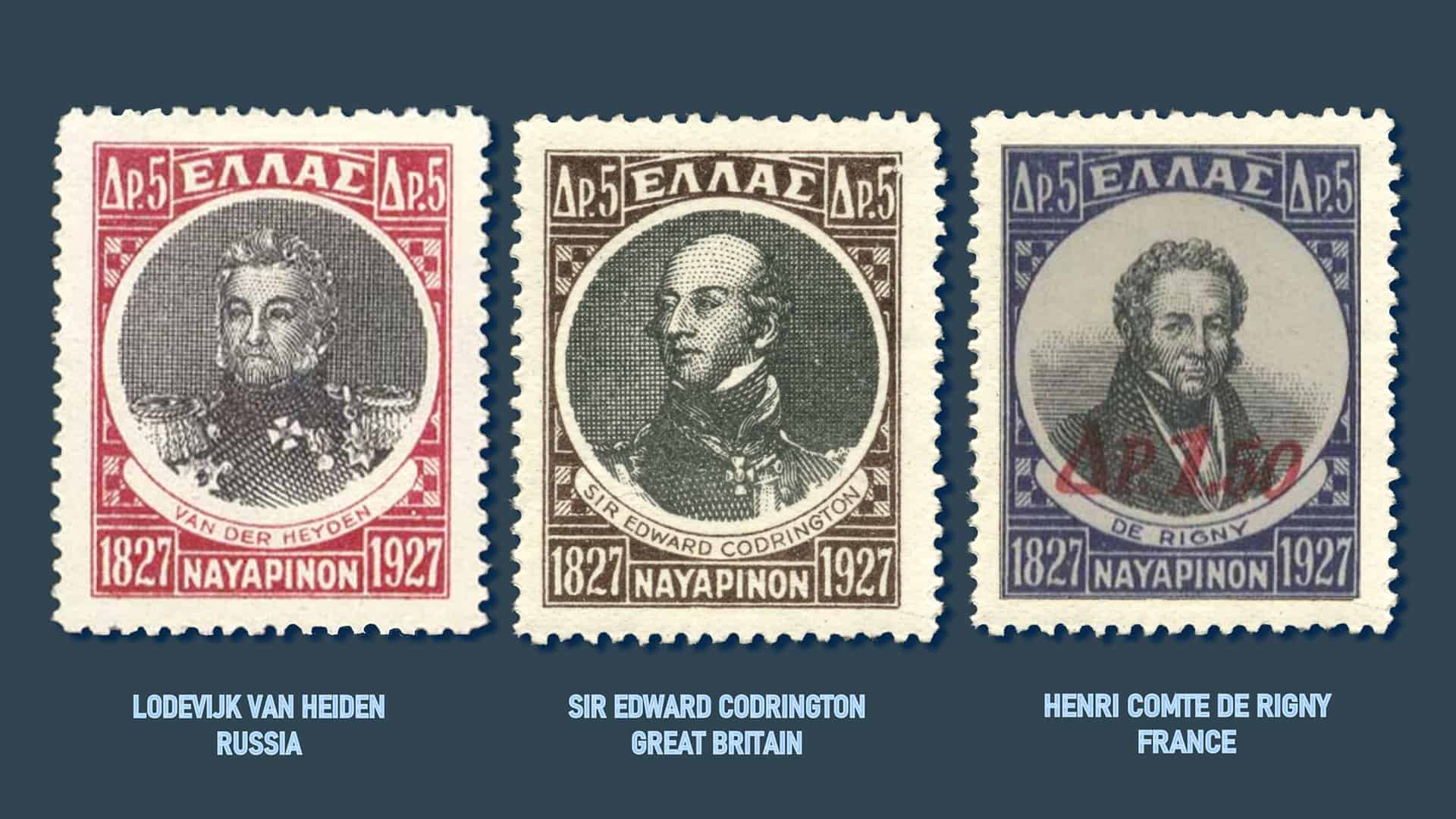The City of Patra, Greece, has a wide, tree-lined street that is named Street of the three Admirals (“Οδός τριών ναυάρχων”), as well as a square named for the “Three Allies.”
. Nobody explained to me as a kid who these people were, so I found out many years later that they were the Admirals in charge of a fleet of allies that went to help the Greek revolution of the 1820s.
But history for kids is naturally different than the “real” story behind the events, so I thought I’d look into it a bit more. My findings were remarkable! Here is what was happening, behind the scenes, in those turbulent years, so critical for the Greek revolution.
The Ottoman Empire at the start of the 19th Century was already on its decline. Its own provinces, allegedly under the suzerainty of the Sultan, were in reality independent. Key to this story is Ottoman Egypt, run by the “wali” (Viceroy, or Governor) Muhammad Ali Pasha. In the North, Orthodox Christian Russia under the Tzars was a perennial enemy of the Ottomans, always having an eye toward absorbing the Ottomans’ European territories as the decline progressed. To this end, Russia would occasionally ferment a resurrection, e.g., by Greeks, to further weaken the Ottoman power from within. A heavy price was paid by Greek patriots when their inadequately supported revolutions failed.
But Russia’s coveting eye was not welcome by the Western Powers of the time, which were, essentially, the British and the “Reconstituted” French (Spain, once mighty, having been reduced by the Napoleonic wars, Germany was not yet a truly united nation, and Italy a shambles.) It was the two Western nations’ key foreign policy to block Russia’s expansion and maintain a comfortable (to them) “balance of power.” To this end, they viewed the Ottoman empire as non-threatening but rather as a convenient check on Russia’s ambitions. As they saw it, all was well, and the status quo was a comfortable situation. Although their educated caste had a definite pro-Greek bias, this was merely an intellectual consideration, not endowed with any desire by their governments to help the actual people living then, in the land of classical Greece.
Greek heroes, encouraged once again by Russia, started their 1821 revolution against the Turks, and were able to establish small enclaves and “free” small areas of the mainland and Morea, and even create, in Nafplion, (Ναύπλιον) a little governmental hearth. But no foreign government had formally acknowledged or recognized them. The patriotic struggle lasted until 1827; it looked like the revolution was about to die one more disheartening time. The number of fighters had diminished, and their little Nafplion government was financially broke. But the fires of freedom were still burning, and the local bands continued their local struggles. To bring an end to this, the Sultan convinced the wali of Egypt, Muhammad Ali Pasha, to send in a sizable land army, and clear off the “infidel rebels.” He promised Muhammad Ali that, upon successful completion, he would give his son, Ibrahim, the large island of Crete as his “fief,” under the suzerainty of the Sultan. This was a tremendous prize!

Morea and key Ottoman figures
So Ibrahim Pasha, a 38-year-old who had known fighting since his teenage years, set off with a large fleet and 15,000 troops for the Morea, landing at Navarino, and started to “clear” the countryside.
As Ibrahim was sailing for the Morea, Russia’s cautious Tzar Alexander died and was replaced by his brother Nicholas I, a more aggressive man of 32. It was decided to help the failing Greek revolt, and in the process, acquire more of the crumbling Ottoman territory, so desirable as part of Russia’s ambitious expansionist policy.
But the British and French were not willing to allow Russia to expand its power. Their policy was strict neutrality, to let the Greek revolution die – which was already at hand – and things to go back to their “normalcy” without the Tzar gaining strength. Smart diplomacy indicated that if they could not physically stop the Russians, they could wrangle them into a joint venture – thus “corral” their actions in a way – and sail together in an expedition aimed – only- at moderating the fervor and atrocities being committed by the Ibrahim army against the Greek population of Morea, and maybe bringing about a truce. Already, Ibrahim was devastating the Morea for two long years since he landed there. Thus, the allied expedition’s primary intent was not to help the Greek patriots (except coincidentally, via an armistice between the Greek rebels and the Ottomans) and stop Russia from advancing their territorial aims.
So, the three Powers signed a “treaty” – really an agreement between them – and combined their navies into a fleet that sailed toward Greece to intimidate the Turco-Egyptians.

The Admirals of the Combined Fleet
Since the British provided the largest fleet, the overall commander was the British Vice-Admiral Sir Edward Codrington, at 57, a well-respected fighting sailor, who had already 44 years service with distinction in many battles, including being captain of the spectacularly aggressive battleship “Orion” at the Battle of Trafalgar, 26 years before. At the time, he was the overall commander of the British Mediterranean fleet.
Along with him went the French fleet, under Admiral Henri de Rigny, 46, and the Russian fleet, under a Dutchman, Admiral Lodewijk van Heiden, 56, who had spent most of his naval career with the Russian navy.
A month of negotiated attempts at some form of truce failed; Ibrahim was still burning villages in the Morea, and independent violent actions by Greek rebels, continued. (A true Philhellene, the ex-British naval officer Frank Abney Hastings, using his own fortune to equip a small steam-powered warship, was fighting the Turk navy – his latest success was at Itea, in the Corinthian Gulf, while the allies were negotiating with the Ottomans.) This lack of cessation of hostilities was leading nowhere. To Codrington – a fighting man – there seemed nothing else to do but make a provocative show of force and bring an end to this.
When the allied fleet arrived at Navarino for the face-off with about 21 formidable (war)ships-of-the-line, the Egyptian fleet with 9 equivalent warships and 20 smaller vessels was already anchored. It was disposed in a tactically excellent arc so that any enemy ships would be under concentrated cannon fire as they approached. (The Turco-Egyptians employed experienced French officers serving in an advisory role – they were warned by the French Admiral and had left the Ottoman ships ahead of time.) But, as there was no war on, the allied fleet sailed into Navarino Bay and sent emissaries to start the expected diplomatic negotiations. (Diplomacy in those days, and under those circumstances, was supported by the mouths of loaded cannon.)

The Naval Battle of Navarino – Painting by Ambroise Louis Garneray
The problem was that when two fleets approach, wary of each other, and mounting – together – over 1,800 great cannon, all loaded and run out, with their touchholes primed, their firing wicks burning, and their largely undisciplined crews ready for instant action, all it would take was an accident, or a single nervous gunner, to start a war. Codrington’s plan was unwise because the risk of events “running away” from his control was too great. His orders were to coerce, to intimidate by superior force, not fight.
Not surprisingly, fate took a turn, and an allies’ auxiliary vessel, sent to deal with some “preliminaries,” was fired upon by some hothead. The fire was returned, and next thing, the whole of both fleets started firing at each other. It’s unclear if there was an effort to stop the shooting, but judging by contemporary accounts, Admiral Codrington’s fighting spirit, and his opinion about his French co-Admiral’s tendency to “too much diplomacy and not enough fighting,” it is doubtful that this effort was made. It was, anyway, impossible to stop once the cannonade started. In the end, the allies’ superior number of guns and gunnery told – severely, and most of the Ottoman fleet is still at the bottom of Navarino bay.
This huge loss of the Ottoman fleet significantly weakened their national strength, so the real winner was naturally Russia – to the detriment of the British and the French. The battle was a resounding military victory, coincidentally aiding the Greek cause, but the Franco-British true mission – to block Russian aims – had failed miserably – in fact resulting in the reverse. Directly as a result of this action, Codrington was recalled to England, to be given awards and banquets, but privately chastised. Although continuing to serve with distinction, he was never again given a serious command.
But he did manage to do a last, conscious, good turn for the Greek patriots; knowing he was being recalled and replaced, he sailed his fleet to Alexandria and convinced (again, with loaded cannon) the wali Muhammad Ali to pull his son Ibrahim out of the Morea, where he had continued his devastation, notwithstanding the loss of his supporting fleet.
So, Greek independence owes little to the diplomacy of the key Powers of the time, but a lot to a grand Fighting Admiral, a Philhellene, whom fate had placed in command of the allied fleet that defeated the Ottomans on that historic day at Navarino, October 20, 1827.

Cannonballs and a mortar bomb at Navarino
The battle of Navarino did not end it all. But as its direct result, it caused, 6 months later, the Russo-Turkish war of 1828-29, plus the sending of a French expeditionary force to the Morea under General Nicholas Maison during the same period, to finally expel the Ottomans. In the treaty of Adrianople that ended the Russo-Turkish war, signed in September 1829, Turkey, which had lost heavily, ceded considerable territories to Russia and formally recognized Greece’s independence. Despite centuries of oppression, the ashes of Hellenes’ generations still contained enough sparks to re-ignite a new beginning.



